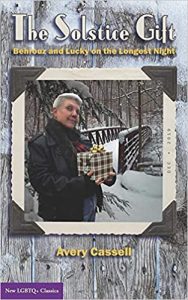The Solstice Gift by Avery Cassell is a queer love story in the best sense of the words. It doesn’t follow the traditional, heterosexual tropes of how the two characters meet and following them through their courtship, but comes in with the love story well under way, and continues with new and radical sexcapades that bring the couple closer together, exploring identity, gender, sex, kink, and love in the process.
The couple, Behruz and Lucky (who you might already know from Cassell’s full-length novel Behruz Gets Lucky, reviewed on the Lesbrary by Anna), are older, both butch, very much in to all kinds of kinky fuckery, and come up with a new way to celebrate winter solstice: with a threesome. What starts as a one-off lark becomes an annual tradition, and becomes elaborate in its ritual and execution.
As a queer, kinky person myself, I loved Cassell’s descriptions of the negotiations, both from a non monogamous and a kink perspective. Cassell clearly knows about the genders, sexualities, open relationship philosophies, and kinks in this book. I love the elaborate references to queer and literary culture — many of which I didn’t understand, but I still like how that adds richness to the prose and feels like a conversational with queer and literary history.
I love reading a queer book with characters who are older, and with a couple who are both butches. Despite more and more representation, graphic sexuality for folks who are over 40 is still rare, and butch/butch desire is not nearly as common as many other gender combinations. I also appreciate how easefully they navigate the openness of their relationship. The book doesn’t go into the envy, jealousy, or insecurities that can come up for open relationships, but I didn’t really miss that content. It just felt like it was more of a queer kinky fairy tale than a real-life depiction of what navigating threesomes is like (I don’t know about you, but in my experience, they are often sexually frustrating, feel incomplete, and end up with someone feeling left out). And sometimes, frankly, I just want the fairy tale version — I want everyone excited to be there, getting off, communicating with exquisite precision, and generally having a gay ol’ time.
It’s a quick read, just over 100 pages, which makes it light enough to zoom through but still full of content and characters that have stayed with me. When I picked up the book again to make notes for this review, I caught myself just turning the pages, jumping in to yet another year’s solstice gift story, since it was so easy to pick it up again from any point and be hooked into the story.
The Solstice Gift was the winner of the 2020 Pauline Reage Novel Award from the National Leather Association International.
Here’s an excerpt from Chapter 8, Leroy King and the Triple Daddies (2017):
Picking the Solstice Gift for 2017 turned out to be easy-peasy. That was the year that our ancient Subaru Forester, Ruby Tuesday, finally shuddered to a halt and nearly went into the Subaru graveyard in the sky, but we decided to put in a last-ditch effort to get it repaired. The owners of the shop we’d been going to, Gay’s Gearhead NoHo Car Repair, had retired, so we asked around for a new mechanic. The consensus was that King’s Automobile Services was the cat’s meow. King’s Automobile Services’ slogan was “King’s: Where queens are kings, kings are queens, and service reigns!”, and they were known for a series of peppy commercials that featured the owner, a dapper stud named Leroy King. Leroy looked to be in her mid-50s, had greying dreadlocks, a fondness for wearing a forest green bandanna as a neckerchief, ironed grey mechanic’s overalls with “King’s” embroidered in curly red script across her chest, deep-set dark eyes behind retro black eyeglasses, and a sparkling gold labrys inlaid in one of her front teeth.
Of course, we had other contenders, but Lucky and I were totally crushed out on Leroy and the others faded into the background like distant stars to Leroy, a luminous full moon. Yeah, we had it bad and this is how it went down.
Read the rest of the excerpt over on Avery Cassell’s site here.
Maybe it’s a little early to start thinking about your own solstice gifts, but if you know some queers who like books, kinky sex, ethical non-monogamy, and queer literary references, this will be a great treat.
Buy it directly from Avery Cassell at their Etsy store (and pick up an embroidered bandana while you’re there, too).


